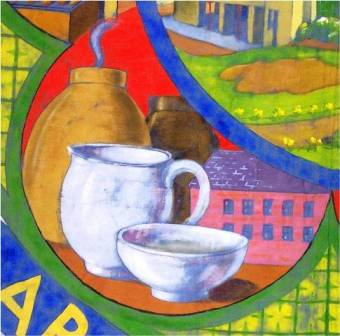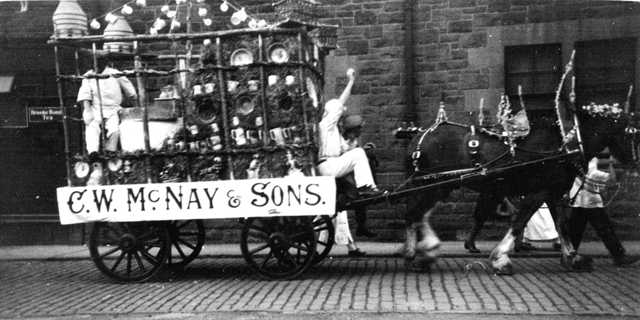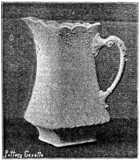




BRIDGENESS POTTERY
Charles Wason McNay married Jane Cox in 1871. They had three sons, William George McNay (born 1875), Josiah Cox McNay (1880)
and Charles David McNay (1885).

In 1887 Charles W. McNay decided to leave the Bo’ness Pottery
and build his own pottery at Bridgeness. The architect was Mr
Simpson of Stirling and Charles’ nephew, John McNay, was
given the job of overseeing the building of the new works.
Charles approached four of his previous associates in the
Bo’ness Pottery to join him, financially, in his new venture.
Robert Lumsden, engineer, Thomas Miller, warehouseman and
packer, James Holland, flintmiller, and one other, a kilnman, all
felt unable to commit themselves in this way but agreed to move
to Bridgeness and work for him, thus forming his expert team.
On 10th December 1887, the local Courier gave the following progress report:
The New Pottery at Bridgeness.
The pottery work being constructed for Mr. C.W. McNay at Bridgeness is being rapidly pushed forward. Besides a long frontage
of brick building, there is a large amount of stone building being put up. The former is for workshops, while the latter is for the
engine and heavy machinery. The buildings are nearly roofed and a good amount of the machinery is placed in position. There
are four kilns finished, while other portions of the work are being energetically pushed on.
Although officially named Bridgeness Pottery, it was also known locally as the Jubilee Works due to its opening coinciding with Queen
Victoria’s Golden Jubilee.
The pottery was officially opened in February 1888 with around 200 girls and men in employment and reached full production by May
1888.
The pottery building and processes were described in the local press as follows:
The pottery occupied a large piece of ground on the north side of the street at Bridgeness. At the east end of the building was
a 112 horse-power engine which did all the heavy grinding work. Refined flint, Cornish stone and various clays were processed
here and after it finally emerged from the pug mill, the clay mixture was ready for use. Behind the engine were two flint kilns,
next to which were two biscuit kilns and two glass kilns.
On emerging from the pug mill, the clay was hoisted to a huge room on the floor above where the jolly, pressing, turning,
handling and spring shops were situated. With the exception of the firing, all ware was finished by the time it left this room.
The ware was then dried in the room below before being transferred to the biscuit kilns after which it became known as biscuit
ware. After the firing, the ware was taken from the biscuit kilns back to the main building where the good ware was separated
from the bad.
After being dipped in glaze, the ware was fired in the glass kilns and then removed to the glass warehouse which had the
gilding and painting shop adjoining.
Behind the kilns were the manager’s office, a fritt furnace for the glaze and moulding, modelling, crate-making and sagger-
making shops.
Behind this was ample space for storing clay and flint.
On Friday, 13th April 1888 the opening of the pottery was celebrated with a supper in the Masonic Hall with over 140 in attendance.
The Annual Conversazione and Dance was held on 1st March 1889. In his address to the company, Charles W. McNay told them
He had no doubt that Bridgeness would be able to hold their own with any manufactory in Scotland.
£5 had been collected from subscriptions made every pay day, so that in the case of serious illness a worker could claim a bed
or advice at the Royal Infirmary (Edinburgh).
He thought some of the men spent their money too freely and they should consider saving one shilling a week in the P.O.
Savings Bank to save the suffering of their wives and children when times were hard.
One year on, on Friday, 28th February 1890, the workers were again attending the annual dance in the Masonic Hall.
The walls were decorated with mottoes such as
Long may Bridgeness Pottery flourish
Success to our annual re-union
United we stand, divided we fall
Success to our annual re-union
United we stand, divided we fall
Around 200 employees and friends were present and they heard that since last year’s gathering there had been a great increase
in business resulting in an increase in the number of employees.
A library had also been established and was proving to be very popular with the workforce.
In August 1896, a deputation of employees of Bridgeness Pottery presented William (Charles’ eldest son) with a gold watch as a token
of esteem on the occasion of his 21st birthday. The presentation was made by senior engineer Robert Lumsden who added that William
had been taking an active interest in the pottery over the past two years.
John McNay was manager of the works until 1898, when he left to manage the West Lothian Pottery.
When the Bo’ness Pottery closed in 1899, Bridgeness bought many of the moulds, transfers, etc and also acquired much of Bo’ness’
trade.
The Pottery Gazette of April 2, 1900 carried the following article:

Mr. Charles W. McNay, Bridgeness Pottery, Grangeroad, Bo’ness, N.B., manufacturer of
general earthenware, is showing commendable enterprise in the development of the
Bridgeness Pottery. He has incurred considerable expense in the introduction of new and
improved machinery, and also in bringing out a number of new shapes and up-to-date
decorations. This is just what a manufacturer of today must do if he aspires to make any
headway at all. Mr. McNay is evidently determined to secure for his works a leading position
in Scotch potteries. We give an illustration of one of his newly registered designs. This is a
new shape for jugs, and, as will be seen, it has some new features that will commend it to
buyers. Apart from its novelty, the shape is a useful one. It is graceful in outline and
carefully modelled.
On 15th December 1900, the kilnmen at both the Bridgeness and West Lothian Potteries went on strike. Both managements stood firm
and the kilnmen returned to work 3 days later after abandoning their claim. Work resumed as normal.
William and his brother Josiah were made partners in the firm in 1901 with Charles (jnr) following later.
Charles (snr) retired from the pottery in 1905 due to serious illness, leaving his sons to manage the business.
On 26th April 1913, 100 pottery workers went on strike, demanding a 15% pay rise and claiming they hadn’t had a pay increase for over
20 years! Management turned down their demand, stating that Bo’ness was ruled by the Glasgow rate and that was the rate currently
being paid. They also reminded them that a recent increase in the Kirkcaldy potteries had only brought these workers level with
themselves. A handful of workers were brought from Staffordshire but after some gentle persuasion from the striking workforce,
including a reminder that imported workers at the last strike had been driven into the Forth, they agreed to return home. After holding
out for 6 weeks, the strikers finally came to an agreement with the management and returned to work on 9th June.
Charles (snr) died in September 1913 from a heart attack, a week after having been thrown from his pony and trap.
His obituary read: By reason of his wide connection, chiefly in Scotland and Ireland, and from being
so long on the road, Mr McNay was one of the best known personalities in the earthenware trade.
Five months after Charles’ death, February 1914, the Bridgeness Pottery was sold.
The Falkirk Herald, 21st February 1914
SALE OF BRIDGENESS POTTERY
There was exposed for sale by public roup within the office of Mr John Marshall, solicitor, Bo’ness,
on Tuesday, the old-established pottery at Bridgeness belonging to the late Mr C. W. McNay.
The ground extends to about three acres, and the works, it was stated, were well fitted with
modern machinery, and were capable of drawing three glost kilns per week.
The feu-duty is £26 9s 2d, and entry was promised for 15th March, 1914.
Mr C. S. Neilson, Falkirk, was the auctioneer, and the works were knocked down at the
upset price of £7000 to Messrs Liddle and Salmon, solicitors, Bo’ness, on behalf of the
two younger sons, Josiah and Charles McNay.
The pottery was erected by the late Mr McNay in 1887, and the buildings,
machinery and plant are said to have cost £13,000.
The pottery had remained with the McNays and Josiah and Charles continued trading as C.W. McNay & Sons.
Production during WWI was greatly affected due to the call up of workers and also government restrictions on the types of wares
produced, however, the government did commission orders from the pottery.
After the war, new techniques such as slip casting were introduced. The pottery flourished in the inter-war period and despite the
depression of the 1920s there was a steady demand for its wares.
Josiah died in 1941 leaving Charles as the sole owner.
During WWII, government restrictions again restricted the wares produced, however, as it was one of the few remaining potteries in
Scotland it benefited greatly by large government contracts to supply hospitals, armed forces, etc.
However, if the government had carried out its original intentions it would not have been handing out contracts but a closure notice.
The following appeared in the Glasgow Herald, January 15th 1942:
The Council deputation was obviously successful with its appeal and after the war, Charles revived the production of domestic and
decorative ware. He encouraged his son, Harry, to become more involved in the daily running of the pottery until eventually Harry was in
full control with Charles in semi-retirement.
Progressing after the war was difficult and finding skilled workers was a problem. In the post war years, Grangemouth’s industries were
developing and requiring manpower and workers were lured from neighbouring towns with the promise of higher wages. Bo’ness’
industries, including Bridgeness Pottery, could not compete with these higher wages and as a result lost many of their workers and had
difficulty in recruiting replacements.
In the week before Christmas 1954, strong gales caused disruptions across the country and forced the cancellation of ferry crossings
across the Forth. Bridgeness Pottery also suffered when a 65 feet section of corrugated roof was ripped off the building.
Harry McNay realised that it was cheaper to import fine pottery than make it and had hoped to change the working practices of the
pottery to include the decorating of imports on a large scale. Unfortunately, he ran out of time.
In December 1957, the workforce of 25 men and 75 women were informed that the pottery would close on the 27th December.
This was due to a combination of many factors:
• travellers had been replaced by sending letters to prospective clients
• machinery and processes needed modernised
• the rising costs of raw materials
• a skilled mould-maker had left due to a pay disagreement
• a chemist was needed
• a general lack of skilled labour
• and wage increases without a corresponding rise in prices
The local Journal and Gazette, 13th December 1957, reported
Concern was shown by Bo'ness Town Council over Bridgeness Pottery,
which is to close down completely on the 22nd or 23rd of the month,
when all stock is exhausted. After a long and somewhat heated
discussion, it was agreed that the most council could do
was to write to Mr McNay appealing to him to try
and keep the Pottery open.
There appears to have been a short stay of execution, as the pottery didn’t close until April 1958. According to the Journal and Gazette,
it was
the last whiteware pottery in Scotland to shut its doors
The building lay empty until 1963, when it was demolished following fire damage.
Closing Down of Bo'ness Factories
Bo'ness Town Council have asked the Secretary of State for Scotland to receive a deputation
on the subject of closing down Bo'ness factories under the Pooling of Products Order.
The latest proposal is to close down Bridgeness Pottery, the one remaining work of its kind in
Scotland, and this, it is asserted, will spell disaster to Bo'ness industrially. Two hosiery
factories in Bo'ness have already had their machinery and labour transferred elsewhere.